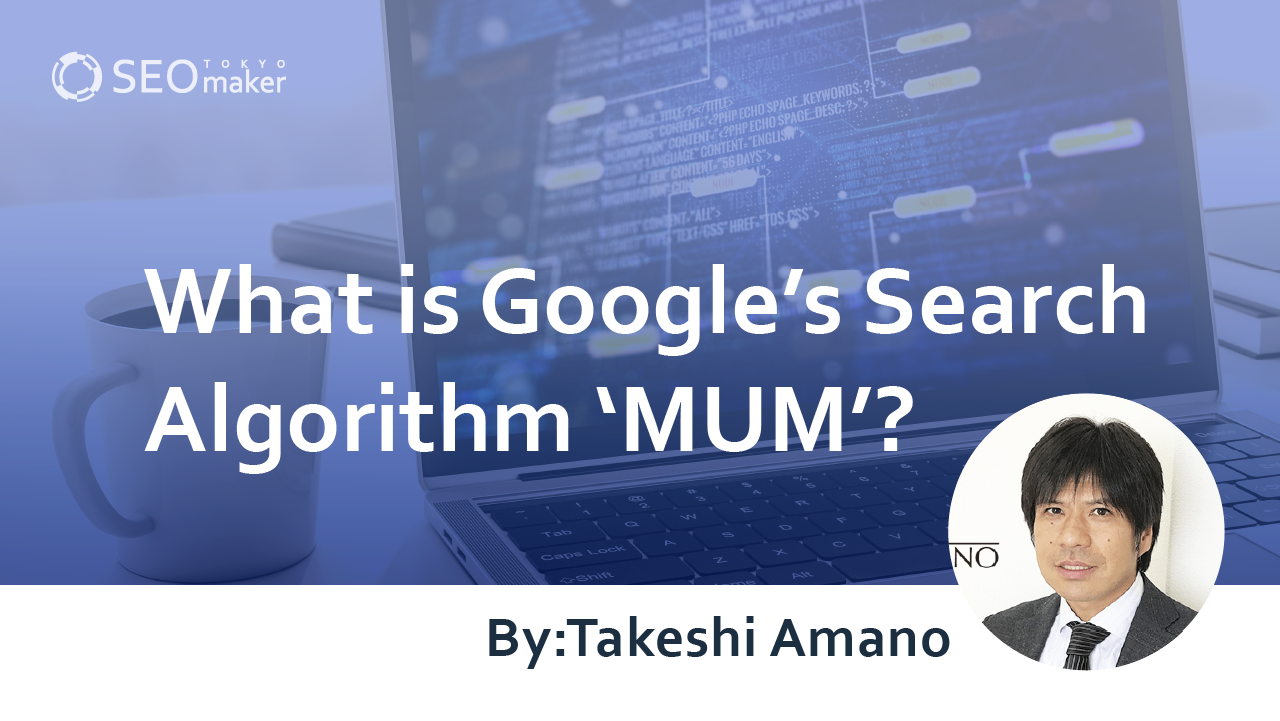What is Google’s Search Algorithm ‘MUM’? : Explaining its Features and Functionality
contents
- 1 What is Google’s Search Algorithm ‘MUM’?
- 2 Capabilities of Google’s MUM Algorithm
- 2.1 Visual Search with Google Lens Integration
- 2.2 Enhancing Understanding through YouTube and Videos
- 2.3 Enhancing Visualization in Search Results
- 2.4 Key Features Enabled by Google’s MUM Algorithm
- 2.5 Get the information you should know with ‘Think to know’
- 2.6 Enhance your search by adding queries with ‘Refine this search’
- 2.7 Expanding Information with ‘Broaden This Search
- 3 SEO Strategies with MUM Implementation
- 4 The Future of Google Search and Lessons for SEO
- 5 Summary

At the Google I/O 2021 keynote held in May 2021, Google announced that they are working on developing a new search algorithm called MUM. This algorithm, which is the next phase of the natural language processing model (BERT) announced in 2019, can understand not only text but also images and provide answers to queries in multiple ways.
In this session, we delve into MUM’s overview and its implications for SEO strategies.
What is Google’s Search Algorithm ‘MUM’?
MUM is an evolution from the BERT algorithm, unveiled in October 2018 by Jacob Devlin and others at Google. MUM stands for Multitask Unified Model.
The Google search algorithm ‘MUM’ is designed to understand both text and images, allowing it to gain a deeper understanding of the world through translation in over 75 languages. It has been introduced to predict the information users need and display it more accurately.
3 Key Features of Google’s ‘MUM’ Algorithm
“MUM” introduces a new feature that can provide search results from various angles, even for needs that are difficult to search with text alone. Let me explain three key features.
- MUM can generate precise answers to text-based queries.
- It allows for refined and expanded search results.
- Based on 75 languages, MUM provides answers that are 1000 times more powerful than BERT.
Feature 1: Providing Accurate Answers from Text Searches
Current search engines do not fully meet the expert-like response level to user queries. A significant attribute of ‘MUM’ is its ability to deliver search results akin to consulting an expert, condensing what would normally take about eight searches to find the desired information into one. MUM offers insights from various perspectives tailored to the user’s context.
For example, consider a user experienced in domestic travel but new to international trips, searching for what’s needed to prepare. This user would need to understand the differences in preparation between domestic and international travel. They have to anticipate and search for different needs for domestic and international travel.
Questions like ‘What plug do I need to charge my phone?’ or ‘What is required to get a passport?’ might necessitate multiple searches. In such complex queries needing multifaceted answers, it could take around eight searches to find the appropriate information.
However, MUM can provide comprehensive answers to vague queries like ‘I’ve traveled domestically but want to go abroad next year. What different preparations are needed?’ based on the search intent.
Reference: Google MUM: A new milestone in AI for understanding information
Feature 2: Refining and Expanding Search Results
MUM has the capability to delve deeper into information related to search intent or to provide a broader perspective. This is facilitated through ‘Refine this search’ for more detailed results and ‘Broaden this search’ for a wider range of related information.
This function enhances the search experience by presenting more detailed and related information, allowing for a deeper and broader understanding.
Feature 3: MUM Provides Answers 1000 Times More Powerful Than BERT Across 75 Languages
Google users searching in various languages may seek different answers to the same question. MUM can learn and understand problems across 75 languages and different search queries simultaneously, including text and images, and eventually expand to video and audio formats.
Although an evolution of the natural language processing model ‘BERT,’ MUM is touted to be 1000 times more powerful, providing nuanced answers across diverse regions and languages, rather than biased information limited to specific areas.
Capabilities of Google’s MUM Algorithm
The capabilities of Google’s MUM include;
- Searching visually through integration with Google Lens
- By incorporating MUM into You Tube and videos, search results become more intuitive and relevant.
- Displaying thumbnails and images for a more tangible grasp of information
Visual Search with Google Lens Integration
MUM integrates with Google Lens, enabling searches based on images. This development means you can search using pictures instead of just words, making it easier to find what you’re looking for when textual descriptions fall short.
For instance, you can take a photo of a color you like and search for a jacket in that color, leading you directly to store links offering such products. Similarly, photographing a broken part and searching for ‘how to fix’ will pull up videos or blogs with repair instructions.
This integration signifies a shift from mere textual searches to a more comprehensive, image-text-based search approach, aiming to not only answer ‘yes or no’ questions but also to suggest new possibilities and solutions.
Enhancing Understanding through YouTube and Videos
“MUM’s technology will now reflect search results in videos and display related content. This technology allows for searching within videos or mentioning search terms within them, and processing with MUM will be introduced for video searches within YouTube.
For example, searching for ‘diet tips’ could bring up a range of related videos covering exercise routines, dietary advice, and motivational tips, providing a more complete understanding of the subject matter.
The advantage of integrating MUM with YouTube is the ability to convey information that might be difficult to grasp through text alone, offering a visual and more comprehensible approach to learning and understanding
Enhancing Visualization in Search Results
Currently, search results are predominantly displayed in text, but the future of search is expected to incorporate a variety of thumbnail sizes, including images and videos. This change will enable users to gain visual insights that text alone cannot provide.
For example, when searching for ‘living room interiors,’ it might be challenging to imagine the colors and designs of ‘Scandinavian style’ or ‘Brooklyn style’ through text alone. However, with the display of thumbnails and images, it becomes easier to visualize these styles. This enhancement not only aids in understanding but also broadens the scope of information accessible visually, leading to a richer discovery of new knowledge.
While small thumbnails currently provide a glimpse into the content, the introduction of larger thumbnails will emphasize the importance of visual elements in search results. Therefore, there’s a growing need to improve the quality of eye-catching images and product photos to convey information effectively to users.
Key Features Enabled by Google’s MUM Algorithm
The implementation of the AI-powered ‘MUM’ has enhanced search capabilities with features like;
- Think to Know Offers a roundup of useful information related to the search query.
- Refine This Search Adds specific queries to the original search term for more detailed results.
- Broaden This Search Expands the scope of the search to provide a wider range of information.
Get the information you should know with ‘Think to know’
The ‘Think to Know’ feature compiles and presents valuable information that users might find beneficial alongside their search results. For instance, a search for ‘watercolor painting’ might bring up a comprehensive list of related information, including techniques, types, styles, tips, and precautions. This feature aims to provide a broad spectrum of necessary information relevant to the search query, allowing users to discover important details they might not have considered.
Enhance your search by adding queries with ‘Refine this search’
The ‘Refine This Search’ function narrows down and suggests more detailed information related to the initial query. For instance, if someone searches for ‘watercolor painting,’ it might show additional related content such as patterns, techniques, or schools for learning watercolor painting techniques. By adding related words to the search query, it enables users to access more in-depth information.
While it may seem similar to the ‘Think to Know’ feature, ‘Refine This Search’ specifically adds new related queries and suggests re-searching to provide more focused information.
Expanding Information with ‘Broaden This Search
In contrast to ‘Refine This Search,’ the ‘Broaden This Search’ feature expands the search scope, offering a broader perspective on the query. Searching ‘watercolor painting,’ for example, might bring up information about famous watercolor artists or gatherings for painting enthusiasts. This broadened display helps even those unfamiliar with watercolor painting to understand the concept from various related information.
‘Broaden This Search’ shows a wide range of topics related to the query, potentially enhancing the quality of search results.
SEO Strategies with MUM Implementation
With the implementation of MUM, searches will extend beyond text to images, deepening and broadening the responses to a single query, thus improving the overall quality of search.
Google will mine and amalgamate necessary information globally, irrespective of language barriers. Content managers will need to delve deeper into topic exploration rather than merely focusing on keyword collection or modification, aligning content marketing with customer behavior and providing comprehensive user engagement points.
Google aims to capture relevant commercial traffic and expand its market share, moving beyond content that merely answers user queries to one that also engages users with related topics.
In the era of MUM, SEO strategies will prioritize enhancing content quality and providing touchpoints that align with customer behavior, rather than focusing solely on keyword optimization.
The Future of Google Search and Lessons for SEO
With the integration of MUM, how will the future of Google search change? MUM is designed to understand user search intent more deeply and broadly. Google aims to conduct extensive training on the currently lacking algorithms for MUM, developing a unique system.
The breakthrough of commercially viable quantum computing is predicted by 2029, suggesting that Google’s new technologies could lead to a higher-quality search engine.
The introduction of MUM is expected to significantly evolve the search engine, necessitating new strategies for SEO in the future Google landscape.
Summary
The integration of Google’s AI, MUM, will further transform search results into more convenient and user-friendly experiences. It is predicted that MUM will provide answers from multiple perspectives even to vague queries, allowing for a deeper understanding. With the inclusion of visual information alongside text, content that was previously difficult to conceptualize will become easier to comprehend. Thus, a greater emphasis should be placed on creating higher-quality content than ever before.










![What is a Description? Explaining the Meaning, Writing Style, and Changing Word Count – [2023 Edition]](https://www.switchitmaker2.com/en/wp-content/uploads/2024/09/what-is-description.webp)










